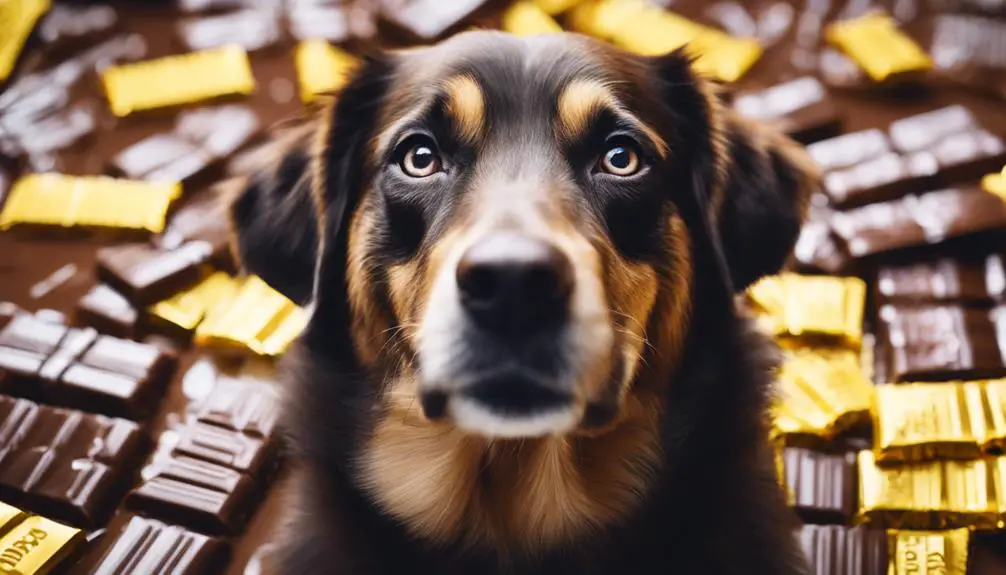How Much Chocolate Can a Dog Eat Kg
I can tell you that dogs should not eat any chocolate at all. Even a small amount can be harmful due to theobromine and caffeine content. The rule is simple: no chocolate for dogs. If you want to guarantee your furry friend stays safe and healthy, it's best to avoid giving them any chocolate treats. If you'd like to learn more about why chocolate is dangerous for dogs, there are additional details available.
Key Takeaways
- White chocolate: small amounts are generally safe for dogs.
- Milk chocolate: moderate consumption may not be harmful.
- Dark chocolate: should be avoided entirely due to high theobromine content.
- Baker's chocolate: extremely concentrated and poses severe toxicity risk.
- Cocoa powder: even small amounts can have high theobromine levels, so avoid it.
Chocolate Toxicity in Dogs

When it comes to chocolate toxicity in dogs, understanding the risks is essential for responsible pet ownership.
As a dog owner, I know that chocolate contains theobromine and caffeine, both of which are harmful to dogs. Dogs metabolize these substances much slower than humans do, leading to a buildup of toxins in their system.
Symptoms of chocolate poisoning in dogs include vomiting, diarrhea, rapid breathing, increased heart rate, and even seizures.
It's important to keep chocolate out of reach of my furry friend and to be cautious during holidays like Halloween and Christmas when chocolate is more prevalent.
If my dog accidentally ingests chocolate, I must contact my vet immediately for guidance on the next steps to safeguard my pet's health and safety.
Understanding Theobromine Poisoning
I'll start by explaining the dangers of theobromine poisoning in dogs, including its toxicity levels, symptoms, and available treatments. Understanding these aspects is vital in recognizing and addressing chocolate toxicity promptly.
Let's explore how theobromine affects our furry friends and what actions can be taken in case of ingestion.
Theobromine Toxicity Levels
Understanding the levels of theobromine toxicity is vital when considering the potential dangers of chocolate consumption for dogs. Theobromine, a stimulant found in chocolate, can be toxic to dogs in certain amounts. Dogs metabolize theobromine more slowly than humans, leading to a buildup of the toxin in their system.
The toxicity levels vary depending on the type of chocolate ingested – dark chocolate contains higher levels of theobromine compared to milk chocolate. Even small amounts of chocolate can cause adverse effects in dogs, and it's essential to be aware of the toxic dose for different dog sizes.
Monitoring the theobromine content in chocolates and keeping them out of reach of pets are key steps in preventing theobromine poisoning in dogs.
Symptoms and Treatment
To effectively address the symptoms and treatment of theobromine poisoning in dogs, it's important to recognize the signs of toxicity early on. Theobromine toxicity can lead to various symptoms, including vomiting, diarrhea, rapid breathing, increased heart rate, muscle tremors, seizures, and even death if left untreated.
If you suspect your dog has ingested chocolate, it's essential to seek immediate veterinary care. Treatment for theobromine poisoning may involve inducing vomiting, administering activated charcoal to limit absorption, providing supportive care such as IV fluids to help flush out the toxin, and closely monitoring your dog's vital signs.
Remember, early intervention is key to a successful recovery for your furry friend.
- Recognize the symptoms of theobromine poisoning.
- Seek immediate veterinary care if ingestion is suspected.
- Treatment may include inducing vomiting and supportive care.
Factors Influencing Toxicity Levels

Taking into account various factors influencing the toxicity levels of chocolate for dogs is important in understanding the risks associated with their consumption. Factors such as the type of chocolate, the dog's weight, and overall health can greatly impact how toxic chocolate can be to a dog. For example, dark chocolate contains higher levels of theobromine, a substance toxic to dogs, compared to milk chocolate. Additionally, smaller dogs are at higher risk due to their size and metabolism. Dogs with underlying health conditions may also experience more severe reactions to chocolate ingestion. Understanding these factors is vital in preventing chocolate poisoning in dogs.
| Factor | Description | Impact |
|---|---|---|
| Type of Chocolate | Dark chocolate has higher theobromine content | Higher toxicity levels |
| Dog's Weight | Smaller dogs are more at risk | Increased risk of poisoning |
| Health Conditions | Underlying health issues can worsen reactions | Severe symptoms may occur |
Symptoms of Chocolate Ingestion
Symptoms of chocolate ingestion in dogs can vary depending on the amount consumed and the dog's size. When a dog ingests chocolate, here are some common signs to watch out for:
- Vomiting
- Diarrhea
- Increased heart rate
These symptoms may range from mild gastrointestinal upset to more severe issues like tremors, seizures, or even death in extreme cases.
As a responsible pet owner, it's important to monitor your dog for any unusual behavior or symptoms if you suspect they've eaten chocolate. If you notice any of these signs, contacting your veterinarian immediately is vital for proper guidance on the next steps to take.
Treatment for Chocolate Poisoning

When a dog ingests chocolate, it's important to recognize the symptoms of poisoning promptly.
Immediate veterinary emergency care is necessary to address chocolate toxicity effectively.
Preventive measures can help avoid such incidents in the future.
Symptoms of Poisoning
Feeling unwell after consuming chocolate can be a sign that your dog may be experiencing poisoning. Some common symptoms of chocolate poisoning in dogs include:
- Vomiting
- Diarrhea
- Increased heart rate
If you notice any of these signs after your dog has ingested chocolate, it's important to take action promptly. While these symptoms can vary in severity depending on the amount and type of chocolate consumed, it's essential to contact your veterinarian or a pet poison helpline immediately for guidance.
Timely intervention is key in treating chocolate poisoning and ensuring the well-being of your furry friend.
Vet Emergency Care
Wondering how veterinarians handle cases of chocolate poisoning in dogs? When a dog ingests chocolate, immediate veterinary care is vital. The treatment for chocolate poisoning typically involves inducing vomiting to remove the chocolate from the dog's system. Additionally, activated charcoal may be administered to prevent further absorption of the toxins. In severe cases, the vet may provide supportive care such as intravenous fluids and medications to manage symptoms like seizures or abnormal heart rhythms. It's important to contact a veterinarian or an emergency animal clinic right away if you suspect your dog has consumed chocolate. Below is a table summarizing the common treatments for chocolate poisoning in dogs:
| Treatment | Description |
|---|---|
| Inducing Vomiting | Removing chocolate from the system |
| Activated Charcoal | Preventing further absorption of toxins |
| Intravenous Fluids | Providing hydration and support |
| Medications | Managing symptoms like seizures |
| Monitoring | Observing for any complications |
Preventive Measures
To prevent chocolate poisoning in dogs, it's essential to store all chocolate products in a secure location out of the reach of pets. Additionally, here are some preventive measures to keep your furry friend safe:
- Keep chocolate products in sealed containers: Prevent access by storing them in airtight containers.
- Educate family members and visitors: Make sure everyone in the household understands the dangers of chocolate for dogs.
- Provide safe alternatives: Offer dog-friendly treats to satisfy their cravings without the risk of chocolate toxicity.
Taking these simple precautions can help avoid the potentially dangerous consequences of chocolate ingestion in dogs.
Safe Chocolate Consumption Guidelines

Enjoying chocolate can be a delightful experience for many, but when it comes to our furry friends, it is important to understand safe consumption guidelines to protect their health. As a responsible pet owner, it's important to know the limits when it comes to sharing chocolate with your dog. Here are some general guidelines to keep in mind:
| Type of Chocolate | Amount |
|---|---|
| White Chocolate | Small amounts |
| Milk Chocolate | Moderate amounts |
| Dark Chocolate | Avoid entirely |
Types of Chocolate to Avoid
Understanding the potential risks associated with different types of chocolate is essential for ensuring the well-being of your beloved canine companion. When it comes to dogs, some types of chocolate are more dangerous than others.
Here are three types of chocolate to avoid:
- Dark Chocolate: Contains higher levels of theobromine, which is toxic to dogs.
- Baker's Chocolate: Extremely concentrated and poses a severe risk to dogs.
- Cocoa Powder: Also high in theobromine and can lead to toxicity even in small amounts.
Being aware of these dangerous types of chocolate can help you protect your furry friend from potential harm.
Preventing Accidental Chocolate Ingestion

Keeping chocolate out of reach and stored securely is vital in preventing accidental ingestion by your dog. I always make sure to store all my chocolate products in high cabinets or closed containers that my dog can't access.
It's also important to educate family members and visitors about the dangers of feeding chocolate to pets. When hosting gatherings, I remind guests not to leave chocolate treats lying around where my dog could find them.
Additionally, being mindful of where I place my chocolate while eating is significant. I never leave it unattended on low tables or countertops where my curious pup could snatch it. These simple precautions can go a long way in ensuring my dog's safety.
Conclusion and Key Takeaways
To conclude, placing an emphasis on the safety of your dog by taking simple precautions can greatly diminish the likelihood of accidental chocolate ingestion. Being mindful of where chocolate is stored, keeping it out of reach, and promptly cleaning up any spills or packaging can go a long way in protecting your furry friend. Remember, prevention is key when it comes to keeping your dog safe from the harmful effects of chocolate consumption. By being proactive and responsible, you can create a safer environment for your pet and avoid the potential dangers associated with chocolate toxicity.
- Store chocolate in secure containers or high places.
- Keep chocolate products out of your dog's reach.
- Clean up any chocolate spills or wrappers promptly.
Conclusion
To sum up, it's vital to remember that even a small amount of chocolate can be toxic to dogs. It's essential to keep all forms of chocolate out of reach and to be vigilant about potential sources of exposure.
If your dog does ingest chocolate, seek immediate veterinary care to prevent serious health complications. Remember, prevention is key when it comes to keeping our furry friends safe and healthy.

If Richie Bedard is a dog food expert, author, or any other figure in the field of dog nutrition that emerged after September 2021,






